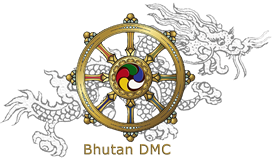Prayer Flags in Bhutan
Prayer flags are an integral part of Bhutanese landscape and also the cultural and religious heritage of the country especially the textile and weaving craft. They are ubiquitous in Bhutan ; in and around monasteries, chortens or stupas, dzongs, lhakhangs,homes, on the railing of bridges and mountain roads, and invariably on or near the summit of the mighty peaks that preside over the country. Red, blue, green, yellow and white, they add a splash of rainbow colours to the rugged landscape.
Deeply religious, the people of Bhutan believe that with each flutter, a flag releases the prayer printed on it into the air which in turn carries it to the heavens. The more the flag flaps, the greater is its divine value. It is for this reason that prayer flags are positioned that catch the wind – high up on the forested slopes of mountains, across bridges, nearby rivers and streams that tumble down the valleys and anywhere where there is wind and tunnel effect. However the intensity of the wind is not the only criteria in positioning prayer flags. They are placed around everything that is sacred and important to the people, from monasteries to homes and farmland, to protect them with a shield of divinity.
The different colour used in prayer flags represent the five elements of nature; red for fire, blue for water, yellow for earth, white for sky and green for vegetation. A typical prayer flag has its central image a horse (Windhorse or lunga la) bearing three flaming wish fulfilling jewels on its back. The three jewels represent the Buddha, the Buddhist teachings and Buddhist community. Around the horse are 20-odd mantras, each dedicated to a particular deity. In addition to the mantras, are prayers for long life and good fortune of the person who erects the flag.
In Bhutan, the prayer flags are known as ‘dhar’ and there are various types of it. Different dhars are raised for different purposes and accordingly mantras are printed on it. Some of the texts and pictures printed on dhar are as under :
Lung Dhar (Wind Horse) : Lung means ‘wind’ and ‘dhar’ means ‘flag’. It is believed that as wind blows and dhar sway in the wind, prayers are unleashed to the heavens, carried by Wind Horse. Wind is compared to the horse but horse carried material things while wind is believed to carry the ethereal things. This dhar is raised to achieve something.
Mani : Usually white in colour without any image or diagram on it this dhar raised after death of a person. The mantra ‘Om Mani Padme Hum’ related with Chenrezig, the God of Compassion is printed on this prayer flag.
Gyeltshen Tsemo (Banner of Victory) : This symbolizes the victory and an image of a cylindrical banner printed at the centre and mantras are printed around. It also includes the Tashi Tagye or ‘Eight auspicious signs’ and are used n ritual and religious procession proclaiming the victory over evil.
Vajra Guru Dhar : These dhar are usually white in colour and image of Guru Rinpoche and the mantra Om Ah Hum Vajra guru Pema Siddhi Hum are printed on this.
There are other general dhars on which mantras, texts, images of Buddha, Goddess Dema (Tar), Chorten, lion, Dragon etc are printed.
HOTELS IN THIMPHU
HOTELS IN PUNAKHA & WANGDUE
HOTELS IN GANGTEY
HOTELS IN TRONGSA
HOTELS IN BUMTHANG
HOTELS IN MONGAR
HOTELS IN TRASHIGANG
HOTELS IN SAMDRUP JONGKHAR
HOTELS IN PHUENTSHOLING
HOTELS IN HAA
HOTELS IN GELEPHU
HOTELS IN ZHEMGANG
RESTAURANTS IN PARO
RESTAURANTS IN THIMPHU
RESTAURANTS IN PUNAKHA
TOUR ITINERARIES
TREKKING ITINERARIES
SPECIAL INTERESTS TOURS
UNIQUE FESTIVALS & FAIRS
BLOG


